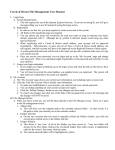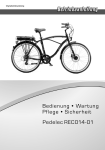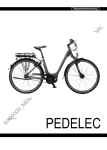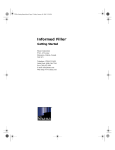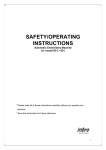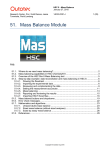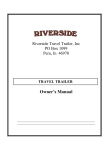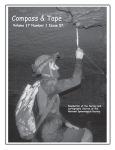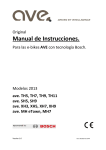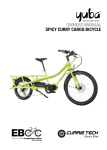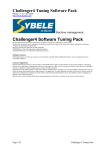Download eFlow E3 Nitro Owner`s Manual
Transcript
E3NITRO Electric Bicycle Owner’s Manual Currie Technologies® 3850A Royal Avenue, Simi Valley, CA 93063 eflowebike.com | currietech.com Version 101 Owner's Manual - eFlow E3Nitro.indd Last modified: April 4, 2013 10:54 AM Contents Section 1Introduction. . . . . . . . . . . . . . . . . . . . . . 3 Section 2 Important symbols and terms . . . . . . . . . . 6–7 Section 3 Recording your bicycle’s important serial numbers . . . . . . . . . . . . . . . . . . . . 8 Section 4 Specifications. . . . . . . . . . . . . . . . . . 9–11 Section 5 eFlow component chart . . . . . . . . . . 12 Section 6 Prior to your first ride . . . . . . . . . . . 13–22 Important safety information. . . . . . 4–7 Bicycle . . . . . . . . . . . . . . . . . . . . . . . . . . . . 9–10 Battery . . . . . . . . . . . . . . . . . . . . . . . . . . . 10–11 Installing a quick release front wheel. . . . . . . . . . . . . . . . . . . . . . . . 15–17 Adjusting a quick release seatpost clamp. . . . . . . . . . . . . . . . . . . . 17–19 Section 7Operation. . . . . . . . . . . . . . . . . . . . 23–38 Section 8 Installing & removing the battery. . . . . 23–24 How to ride. . . . . . . . . . . . . . . . . . . . . . . . . . 25 Operating modes. . . . . . . . . . . . . . . . . . . . 26 Display details. . . . . . . . . . . . . . . . . . . . . 27–35 Gears & shifting. . . . . . . . . . . . . . . . . . . . 35–36 Range & tips . . . . . . . . . . . . . . . . . . . . . . 37–38 Battery care. . . . . . . . . . . . . . . . . . 39–45 Charging . . . . . . . . . . . . . . . . . . . . . . . . . 40-43 Storage. . . . . . . . . . . . . . . . . . . . . . . . . . . 43–44 Disposal . . . . . . . . . . . . . . . . . . . . . . . . . . . . 44 Section 9Troubleshooting. . . . . . . . . . . . . . . 45–48 Flat tire . . . . . . . . . . . . . . . . . . . . . . . . . . . 46–50 Currie Tech Technical and Customer Service: +1 800-377-4532 p. 2/52 I. Introduction: A word about this Owner’s Manual and your safety… Dear Customer, Currie Tech would like to thank you for purchasing our product. Cycling (electric or otherwise) can be a hazardous activity, no matter what type of bicycle you ride. Traffic, weather, distractions, and many other factors can endanger you while using any type of bicycle or vehicle. Mistakes and accidents can lead to severe injury or death so please read this manual before riding our product. You have a responsibility to learn how to operate your new bicycle safely and correctly. Keep it in good shape by maintaining it and making sure that anyone who uses it knows how to operate it safely. Please take the time to read and understand the following warnings and cautions. Throughout this manual we will attempt to reinforce the guidelines that we have summarized below. This is important. If others use your bicycle, please show this section to them so that they are aware of these important guidelines to help avoid accidents and reduce the severity of injuries when they occur. Thank you. p. 3/52 II. Important Safety Information • Helmets: There is no single factor that works better at reducing the severity of injuries sustained in bicycle accidents more than a quality bicycle helmet. Please don’t ever ride your bicycle without one. • It’s not a tandem: Your bicycle was engineered to carry one (1), [that is a single rider,] person safely. The rack on the back is for luggage or a battery. Overloading the bicycle with a second rider is a bad idea that can lead to severe injury or death! Not to mention the fact that you will severely impact the performance of the bicycle. • It’s the law; obey it: Obey all traffic laws. Always ride on the right side, with, not against, traffic. STOP signs and traffic lights apply to cyclists as well as cars and pedestrians. • Be alert to conditions around you! Unfortunately, a motorist that has successfully parallel parked his/her car is not always thinking about the cyclist fast approaching from behind. An impact with a car door suddenly opened into your path will ruin your day. • Weather: If you get caught in rain or snow, please be aware that distance to stop your bicycle may double or triple over the distance that it takes under dry conditions. Ride more slowly and anticipate your stops by applying the brakes MUCH earlier. Don’t forget that the roads are a lot more slippery when wet. Bicycle tires don’t grip wet pavement as well as dry pavement. Take the corners carefully. Currie Tech Technical and Customer Service: +1 800-377-4532 p. 4/52 • Night time: Motorists have a hard time seeing you when the sun goes down. We make the bicycle easier to see with reflectors, and you can help with additional lights and strobes (available accessories). However, even with these additional features, you’re still not as visible as in the daytime. If you must ride at night, wear light-colored clothing, preferably with reflective strips. Buy a flashing LED light and use it. Make sure that the reflectors on your bicycle are properly positioned and clean. Use the headlight so that you can see the obstacles in your path. Ride more slowly. Be wary of cars and assume that they do not see you. • Maintenance: It worked fine when we put it in the box: Please maintain your bicycle. We have included maintenance instructions in this manual. We’re smart guys, but we haven’t figured out how to make a bicycle that takes care of itself. Check the brakes and the tires and the tightness of all those important fasteners before each and every ride. Pretend that you’re a pilot doing a walk-around of his airplane before taking-off. The pilot knows that his life depends on the airworthiness of his plane; your life depends on the roadworthiness of your bicycle. Please have your bicycle checked by a qualified bicycle mechanic AT LEAST once a year. It’s a small investment in your well-being. • Battery: We have equipped your eFlow bicycle with a state-of-the-art lithium ion battery. This is the same battery chemistry that powers your cell phone and laptop, but on a much bigger scale. Lithium ion batteries feature the highest gravimetric energy density available. (How’s that for engineering techno-speak? What it means is that you get more energy per pound than with any other battery chemistry.) We have built-in a sophisticated battery management system (BMS) that helps control all that p. 5/52 energy. But the battery requires care and maintenance to ensure that it will perform safely and reliably for many miles of riding. We have devoted an entire chapter of this manual to the battery. Please read and understand this important information. As always, if you have any questions, please don’t hesitate to contact us. If you have a question about any aspect of riding your bicycle, please don’t hesitate to give us a call. We love to talk about the safe use of our products. Or call the Authorized Dealer where you purchased the bicycle. Remember, we love to do anything that we can to make sure that you remain a healthy and loyal customer. IN SUMMARY: 1. WEAR A HELMET EACH AND EVERY TIME YOU GET ON THE BICYCLE! 2. Don’t carry passengers. 3. Obey the Rules of the Road. 4. Ride defensively! Watch out for both moving and stationary cars. 5. Be careful in wet conditions. Braking and traction are significantly reduced. 6. Ride carefully at night and make sure you are wearing high visibility reflective clothing. 7. Maintain your bicycle. 8. Care for your battery. 9. Read and study the rest of this manual. 10.If you do not understand any aspect of the use and care of your bicycle, PLEASE call us: Currie Tech Customer Service: (800-377-4532). Important Symbols and Terms This Owner’s Manual uses the following symbols and terms to call your attention to Warnings, Cautions and Notes: Currie Tech Technical and Customer Service: +1 800-377-4532 p. 6/52 Term: WARNING Meaning: This term calls attention to a Warning. A Warning indicates a potentially hazardous situation, which if not avoided, could result in bodily injury or death, in addition to property damage. Read the text accompanying the warning to be aware of the specific hazard. Term: CAUTION Meaning: This term calls attention to a Caution. A Caution indicates a potentially hazardous situation, which if not avoided, may result in damage to equipment or inadvertent system failure. Read the text accompanying the Caution to be aware of the specific hazard and avoid damage or system failure. Term: Note: Meaning: This term calls attention to a Note. The text accompanying a Note provides helpful or other important related information. Please read, understand and follow all Warning, Caution and Note notices on your eFlow bicycle and those included in this Manual. If you do not understand any of this important information, please contact your selling dealer or the Currie Tech Customer Service Department at 800-377-4532. Related Manuals: Many of the components that are installed on your eFlow bicycle have manuals that provide operating and maintenance instructions regarding those particular components. Please read and understand the important information contained in those manuals as well. p. 7/52 III. Recording Your Bicycle’s Important Serial Numbers: Your bicycle and certain key components have unique serial numbers. We urge you to record these serial numbers for warranty purposes or in case your bicycle is ever lost or stolen. Bicycle: The bicycle’s serial number is located on the underside of the frame near the pedal crank: Bicycle serial number: _ _____________________________ Motor: The motor serial number is on a label attached to the left side of the motor hub: Motor serial number: _____________________________ Battery: The battery serial number is on a label affixed to the right side of the battery: Battery serial number: _____________________________ Please also record this other important information: Date of Purchase:______________________________ Selling Dealer: ______________________________ Street Address: ______________________________ City/State/Zip: ______________________________ Telephone: ______________________________ Salesman: ______________________________ Please keep this information in a safe place for future reference. Currie Tech Technical and Customer Service: +1 800-377-4532 p. 8/52 IV. Specifications* • Performance o Maximum speed: 20 miles/hour (32 kilometers/ hour)* o Maximum range: Up to 20 miles (32 kilometers)* (with standard battery pack) o Maximum Weight: 275 lbs (125 kilograms) *Note: many factors affect speed and range capabilities of the eFlow bicycle. Terrain, average speed, rider weight, tire inflation pressure, winds, hills, etc., all have an impact on how far and how fast you go. Please see the Operations section of this Owner’s Manual for more details. • Operating modes o Power-On-Demand Mode (POD): Motor power regulated by a twist-grip throttle o Pedal Assist Mode (PAS): Motor power proportional to rider pedaling effort • Bicycle o Frame Aluminum o Frame size 14.5” o Front fork: RST SS-A6-T shock front fork o Handlebar: Kalloy FB-13 o Handlebar stem: Kalloy AS-025 o Grips:Velo VLG-311 o Rims: 26” Alex FR-30 aluminum o Tires: Maxxis M2003 26” x 2.0” o Tubes: CST 26” x 2.0” o Front derailleur SRAM Apex (2 x 10) o Rear derailleur SRAM Apex (10 speeds) o Shifters SRAM SL700 Flatbar trigger o Front brake: Tektro AURIGA E-SUB 51M o Rear brake Tektro AURIGA E-SUB 51S o Saddle:Velo VLG-311 p. 9/52 • Motor o Type: TDCM brushless, gearless hub motor o Power rating: 500-watts • Standard Battery Pack o Model:HTEnergy o Chemistry:Lithium Ion o Configuration: 10S5P, 2.2 Amp-hr 18650 cells o Rated voltage: 37 Volts o Rated capacity: 11Ah (407 watt-hrs) o Weight: 3.9 kg (8.6 lbs) o Max discharge current: 26A o Over-discharge limits: 2.30V±0.025V per cell o Pack cut-off voltage: 30V±4V o Charge method: Constant Current/Constant Voltage o Over-charge limits: 4.25V±0.025V per cell o Max charge current: 5A (0.5C5) o Max charge voltage: 42V o Internal resistance: ≤150mΩ • Optional, High Capacity Battery Pack o Model:HTEnergy o Chemistry:Lithium Ion o Configuration: 10S8P, 2.2 Amp-hr 18650 cells o Rated voltage: 37 Volts o Rated capacity: 17.6Ah (634 watt-hrs) o Weight: 5.2 kg (11.4 lbs) o Max discharge current: 26A o Over-discharge limits: 2.30V±0.025V per cell o Pack cut-off voltage: 30V±4V o Charge method: Constant Current/Constant Voltage o Over-charge limits: 4.25V±0.025V per cell o Max charge current: 5A (0.5C5) o Max charge voltage: 42V o Internal resistance: ≤150mΩ Currie Tech Technical and Customer Service: +1 800-377-4532 p. 10/52 • Charger oModel: HP8204L3(10S)/36V2A oDimensions: 188mm x 93mm x 53mm oWeight:850g (1.8lb) oInput voltage: AC110V~264V/47~63HZ oOutput voltage: 42±0.5VDC oOutput amperage: 2.0±0.2A oAC line fuse rating: 10 amp *Note: Specifications are subject to change without notice. p. 11/52 V. eFlow Component Chart 6 4 1 5 2 14 7 3 17 11 8 16 15 12 13 10 9 1. Saddle (seat) 2. Seat post/Battery pack 3. Quick-release seat post clamp 4. Adjustable handlebar stem 5. Throttle 6. Display 7. Front tire/wheel 8. Front disc brake 9. Pedal 10.Crank arm 11.Chain ring 12.Kick stand 13.Drive chain 14.Rear tire/wheel 15.Rear derailleur 16.Rear disc brake 17.Rear hub motor Currie Tech Technical and Customer Service: +1 800-377-4532 p. 12/52 VI. Prior to your first ride IMPORTANT NOTICE: All Currie Tech products are intended to be delivered in a completely assembled and adjusted condition. To ensure your total satisfaction, the agreement that we sign with our dealers prohibits the sale of an unassembled Currie Tech product. If you are sold an unassembled Currie Tech vehicle, please call our Customer Service Department at (800) 377-4532. WARNING: There are no user serviceable elements incorporated into the motor, motor controller, battery, battery charger, throttle, or wiring harness of your Currie Tech electric bicycle. DO NOT ATTEMPT TO DISASSEMBLE OR ADJUST ANY OF THESE COMPONENTS. Doing so may cause extensive damage to these components, will void your warranty, and may cause a hazardous condition. If you cannot resolve a problem using the troubleshooting guide in Chapter IX, contact your Currie Tech authorized dealer, or call the Currie Tech Customer Service Department at (800) 377-4532 for assistance. Note: Throughout this manual, we will refer to the “right side” and the “left side” of the bicycle. For clarification purposes, “left” and “right” are relative to your position when sitting on the bicycle in the normal riding position. Note: It is important to fully charge the battery prior to first use. Unpack the battery and battery charger, and charge the battery (per the instructions found in Section VIII of this manual) for at least 8 hours before using the bicycle for the first time. Before you ride: Use the following checklist to ensure that your eFlow bicycle is ready for safe and enjoyable use. • Quick releases: Make sure that the front wheel quick release and seat height adjustment quick release are properly adjusted and tight. p. 13/52 WARNING: Failure to properly adjust and lock the front wheel quick release may result in the inadvertent separation of the front wheel while you are riding the bicycle. This occurrence can result in serious injury or death, and property damage. Please refer to the instructions below for the proper installation and adjustment of the front quick release hub. If you are uncertain about any aspect of the assembly and adjustment of your bicycle, seek help from a qualified bicycle mechanic or the Currie Tech Customer Service Department at (800) 377-4532. Your eFlow bicycle uses quick release (QR) levers to facilitate common tasks such as front wheel removal and seat height adjustment. When properly adjusted, quick release levers are both safe and convenient, but you must understand and apply the correct technique to adjust them properly before riding your bicycle to prevent serious injury or death from a fall. Quick release levers use a cam action to clamp the wheel or other components in place. Because of their adjustable nature, it is critical that you understand how they work, how to use them properly, and how much force you need to apply to secure them. Warning: The full force of the cam action is needed to clamp the wheel or other components securely. Holding the nut with one hand and turning the lever like a wing nut is NOT a safe or effective way to close a quick release and will not clamp the wheel or other components safely. Currie Tech Technical and Customer Service: +1 800-377-4532 p. 14/52 WHEEL QUICK RELEASE USAGE Riding with an improperly adjusted wheel quick release can allow the wheel to wobble or fall off the bicycle, which can cause serious injury or death. Therefore, it is essential that you: 1. Ask your dealer or a local bike shop to help you make sure you know how to install and remove your wheels safely. 2. Understand and apply the correct technique for clamping your wheel in place with a quick release. 3. Each time, before you ride the bike, check that the wheel is securely clamped. Installing a quick release front wheel In a quick release system, the wheel hub is clamped in place by the force of the quick release cam pushing against one dropout and pulling the tension-adjusting nut, by way of the skewer, against the other dropout. (Please refer to the illustrations below.) The amount of clamping force is controlled by the adjustment of the tension-adjusting nut. Turning the tension-adjusting nut clockwise while keeping the cam lever from rotating increases clamping force; turning it counterclockwise while keeping the cam lever from rotating reduces clamping force. Less than half a turn of the tension-adjusting nut can make the difference between safe clamping force and unsafe clamping force. p. 15/52 1. Remove the tension adjusting nut and one of the small springs, then slide the quick release skewer through the hub. If your bicycle has a disc brake, insert the skewer starting on the side with the brake rotor. Replace the spring and tension adjusting nut (fig. a). 2. If your bicycle has rim brakes, disengage them to increase the clearance between the tire and brake pads. 3. Install the wheel into the dropouts, making sure the quick release lever is on the left side of the bicycle. 4. Holding the quick release lever in the OPEN position with one hand, tighten the tension adjusting nut with your other hand until it is finger tight against the fork dropout. 5. While pushing the wheel firmly to the top of the slots in the fork dropouts, and at the same time centering the wheel rim in the fork, move the quick release lever upwards and swing it into the CLOSED position (figs. b & c) The lever should now be parallel to the fork blade and curved toward the wheel. To apply enough clamping force, you should have to wrap your fingers around the fork blade for leverage, and the lever should leave a clear imprint in the palm of your hand. Currie Tech Technical and Customer Service: +1 800-377-4532 p. 16/52 WARNING: Securely clamping the wheel takes considerable force. If you can fully close the quick release without wrapping your fingers around the fork blade for leverage, and the lever does not leave a clear imprint in the palm of your hand, the tension is insufficient. Open the lever; turn the tension adjusting nut clockwise a quarter turn; then try again. 6. If the lever cannot be pushed all the way to a position parallel to the fork blade, return the lever to the OPEN position. Then turn the tension-adjusting nut counterclockwise one-quarter turn and try tightening the lever again. 7. Re-engage the brake to restore correct brake pad-to-rim clearance; spin the wheel to make sure that it is centered in the frame and clears the brake pads; then squeeze the brake lever and make sure that the brakes are operating correctly. WARNING: An improperly secured seat post could lead to loss of control of the bicycle while riding, causing an accident that may result in serious injury or death, and property damage. If you are not sure how to properly adjust and apply the quick release seat post clamp, please consult your authorized Currie Tech dealer, or the Currie Tech Customer Service Department at (800) 377-4532 for additional instructions. Adjusting a quick release seat post clamp In a seat post quick release system, the seat post is clamped in place by the force of the quick release cam pushing against one side of the clamp and pulling the tension adjusting nut, by way of the skewer, against the other. The amount of clamping force is controlled by the tensionadjusting nut. Turning the tension-adjusting nut clockwise while keeping the cam lever from rotating increases clamping force; turning it counterclockwise while keeping p. 17/52 the cam lever from rotating reduces clamping force. Less than half a turn of the tension-adjusting nut can make the difference between safe clamping force and unsafe clamping force. 1. With the quick release clamp in the OPEN position, insert the seat post, with saddle attached, into the bicycle’s seat tube. (Refer to the illustrations above.) 2. Swing the quick release lever into the CLOSED position. 3. Grab the saddle with both hands and attempt to push it down. 4. If you are able to force the seat post further into the frame, the seat post clamp needs to be adjusted. Holding the quick release lever in the OPEN position with one hand, tighten the tension-adjusting nut with your other hand about 1/2 turn clockwise. 5. Attempt to swing the lever into the CLOSED position. If the lever cannot be pushed all the way to the CLOSED position (fig. b), return the lever to the OPEN position, then turn the tension adjusting nut counterclockwise one-quarter turn and try tightening the lever again. Repeat steps 3, 4 & 5 until Currie Tech Technical and Customer Service: +1 800-377-4532 p. 18/52 proper quick release tension is achieved. Tires: Bicycle tires normally lose pressure over time. An under inflated tire can cause premature tire failure, and will require significantly more energy (electric and human) to propel the bicycle. Low tire pressure will have a significant negative impact on battery range. Ensure that both front and rear tires are inflated to the recommended tire pressure indicated on the sidewall of the tire. Check the tires for any damage or unusual wear. The tire should be properly seated in the rim and the fit of the tire bead in the rim should be periodically checked. Ensure that the tire is not cracked or excessively worn. Check for foreign objects in the tread, and that the valve stem is straight in the rim. Damaged or worn tires should be replaced immediately. Take the bicycle to a qualified bicycle mechanic to repair and/or replace your tires if necessary. Reflectors: Your bicycle comes equipped with eight (8) reflectors (front handle bar, rear fender, front wheel, rear wheel and two each on the left and right pedals) to make you more visible at night. Please ensure that those reflectors are in place, properly positioned and clean before each ride. Drive chain: Your eFlow bicycle is equipped with a high quality roller chain that needs to be cleaned and lubricated regularly. p. 19/52 Brakes: Check your brakes before each ride. WARNING: Riding with brakes that are damaged, excessively worn and/or misadjusted will significantly degrade the stopping capabilities of your bicycle. This condition could lead to an accident resulting in serious injury or death, and property damage. If you are uncertain about any aspect of the assembly and/or adjustment of your bicycle, seek help from a qualified bicycle mechanic or the Currie Tech Customer Service Department at (800) 377-4532. WARNING: Bicycle brakes lose effectiveness when wet. Avoid riding in wet weather. If it is unavoidable, be aware of the fact that stopping your bicycle will require extra distance. Ride more slowly, keep a greater distance between yourself and other traffic, and begin braking sooner than normal. Failure to take these precautions could lead to an accident causing serious injury or death, and property damage. If you are uncertain about any aspect of the brake operation under any condition, seek help from a qualified bicycle mechanic or the Currie Tech Customer Service Department at (800) 3774532. Test the function of your brakes by riding your bicycle in an area free from traffic and obstructions prior to every ride. • Brake cut-off switches: To maximize the effectiveness and efficiency of the braking system, and to save battery power, your eFlow bicycle uses a system that turns power to the motor “OFF” when the brakes are applied. Check the function of the brake cut-off switches before each ride. To do so, turn the power “ON”, set the Mode to POD (see below), lift the rear wheel off the ground by pushing the bicycle onto the lowered kickstand, and actuate the throttle. Currie Tech Technical and Customer Service: +1 800-377-4532 p. 20/52 CAUTION: Ensure that there is no one standing close to the rear wheel, and that all clothing and other objects are a safe distance away from the rear wheel when performing this test. The rear wheel will spin at high speed during this test. If necessary, ask a friend to assist with this test. With the rear wheel off the ground, actuate the twist grip throttle on the right side of the handlebar. The electric motor will spin the rear wheel. With the throttle partially actuated, alternately apply the left and right brake levers. When the brake lever is applied, power to the motor should turn “OFF”. Power will resume when the brake lever is released, assuming that you continue to actuate the throttle. Note: Fully applying the right brake lever will not only turn off the motor, the brake should also stop the spinning wheel. If actuation of either brake lever does not cause power to the motor to turn off, consult your Currie Tech authorized dealer, or the Currie Tech Customer Service Department at (800) 377-4532. • Battery: Use ONLY the battery supplied with your eFlow bicycle. CAUTION: Use of any battery not supplied with your eFlow bicycle WILL void the warranty and may cause damage to the electrical system of the bicycle and the hub motor. Use only the battery supplied with the bicycle, or a battery provided by Currie Tech as a replacement for the battery supplied with the bicycle. • Note: Prior to its first use, charge the battery supplied with your bicycle for at least eight (8) hours. p. 21/52 WARNING: Use only the charger supplied with your battery. If you use any other battery charger, you will void the warranty, you may damage the battery and you could cause a fire that would result in property damage and possibly injury or death. Follow the instructions for battery charging in Section VIII, and in the Battery & Charger Instruction Manual supplied with your bicycle. Note: If you plan to store your bicycle in excess of thirty (30) days, please follow the battery storage guidelines given in the Battery Storage instructions in Section VIII, and in the Battery & Charger Instruction Manual supplied with your bicycle. WARNING: Failure to properly use, charge and store the battery supplied with your eFlow bicycle will void the warranty and may cause a hazardous situation. Please read and follow all instructions for the use and care of the battery provided with your bicycle. If you are uncertain about any aspect of the use and care of your battery, please do not hesitate to call the Currie Tech Customer Service Department at (800) 377-4532. Currie Tech Technical and Customer Service: +1 800-377-4532 p. 22/52 VII.Operation Installing the battery Your eFlow E3Nitro electric bicycle is equipped with a battery pack that is nested in the frame in the seat tube. This unique and patented design feature allows for optimum battery placement from a weight distribution standpoint, while allowing the bike to maintain clean, aerodynamic lines. To install the battery: oElevate the ‘shoe’ in the seat mast to its highest position and lock it in place with the seat post quick release. oPosition the battery with the nose of the saddle pointing toward the front of the bike, taking care to align the mounting groves of the battery with the mating groves in the shoe. (See photo.) The battery “shoe” oPush the battery to the rear of the shoe until the connector on the battery pack securely engages with the connector in the shoe. p. 23/52 oUnlock the position of the seat post by opening the quick release lever. Lower the seat post to the desired riding position, then securely clamp the seat post quick release. oRefer to the instructions for the operation of the seat post quick release on Page 17. To remove the battery: oLoosen the seat post clamp quick release lever by rotating the lever to the OPEN position. (See photo.) oElevate the seat/seat post/battery assembly all the way to the top-most extent of its travel, exposing the battery ‘shoe’ to which the battery is connected. (See photo.) oClose the seatpost quick release lever to lock the shoe in place. Gently tap the battery toward the front of the bike to disconnect the battery from the connector in the shoe. Remove the battery. Currie Tech Technical and Customer Service: +1 800-377-4532 p. 24/52 How to ride Before you turn the bike on and start riding, you should understand the way the pedal torque sensor works. Mounted in the drive-side rear dropout, the torque sensor measures the very slight deflection in the dropout plate that occurs when you pedal. Based on this measurement, the sensor outputs a signal to the controller which is processed further and ultimately translated into motor output. In order to properly measure relative deflection of the sensor, the controller first needs to recognize a “zero point”. This zero point is calculated each and every time the bike is turned on, immediately after you push the power button. Because the sensor zero point is the basis for all measurement in the system, it’s important that it be very accurate, considering the conditions the bike is being used under; most importantly, the weight of the rider. Because of this, we recommend you follow this procedure every time you turn the bike on: 1. Sit on the bike, putting as much of your weight on the saddle as possible. Put your feet on the floor for balance, but try not to rest too much weight on them. 2. Press the SET button on the display to turn the bike on. 3. Wait a second or two, then begin riding. For the best ride, do not put your feet on the pedals, and do not begin moving the bike until after powering up the system as recommended above. Although the software is fairly forgiving, it’s possible that the bike could be too sensitive, or not sensitive enough to ride ideally if the procedure isn’t followed. p. 25/52 A note about operating modes: Your eFlow electric bicycle features two operating modes: 1. Power-On-Demand Mode (POD) 2. Pedal Assist Mode (PAS) In Power-On-Demand Mode (POD), motor power is regulated by actuation of the twist-grip throttle mounted on the right-hand side of the handlebar. Twist the throttle toward you to apply motor power. Pedaling is optional. Power is available whether you pedal or not. The position of the throttle will determine how much power is applied. To terminate power, release the throttle allowing it to return to its “OFF” position. In Pedal Assist Mode (PAS), motor power output is dependent on the rider’s pedaling power. In other words, the bike’s electrical system ‘senses’ rider pedaling effort, and applies motor power in proportion to rider effort: the harder you pedal, the more motor power is applied. The proportion of the ‘Assist’ is set via the display (see the following pages). If the rider does not pedal, no power is output from the motor. Ceasing pedaling during the ride will cause the motor to turn off. Motor power will be restarted when the rider begins pedaling again. While in Pedal Assist Mode (PAS), you can override the PAS function with the throttle. After beginning to ride, rotate the throttle toward you to achieve any percentage of motor power up to 100%. Currie Tech Technical and Customer Service: +1 800-377-4532 p. 26/52 Display Your eFlow E3Nitro electric bicycle is equipped with a multifunction display that also serves as a security device. By removing the Display from the handlebar, you disable the electrical system of the bicycle, preventing unauthorized use. HOWEVER, removal of the Display DOES NOT prevent theft of the bicycle. If you plan to leave the bike unattended, even for a short time, in addition to removing the display, securely lock the bike to an immovable object with a high quality chain- or cable-locking device. The display is your user interface to the bike. Using the display, you can program the riding characteristics of the bike, monitor the system self-tests as they occur, and note any system errors. The display also serves as a cycle computer, giving information regarding time, speed and distance. p. 27/52 Connecting the display 1 Place the display on the handlebar display mount at a 45° angle, aligning the tabs on the bottom of the display with the slots on the face of the mount. 2 While pushing down on the display, rotate it 45° clockwise until it stops, parallel with the handlebars. 3 Sit on the bike, then turn it on by pressing the SET button. Currie Tech Technical and Customer Service: +1 800-377-4532 p. 28/52 Setting the clock and speed units 1 Hold SET and “–” together for 5 seconds to enter setup mode. In setup mode, you will enter codes corresponding to the setting you wish to change. 2 Tap SET to cycle between digits. Hold to confirm after the code is entered. Tap “+” or “–” to set each digit in the code. Codes: Set clock: 0001 Set speed units: 0003 Please do not experiment with undocumented codes. While other settings exist, using them may cause the bike to become unsafe to ride or to stop functioning altogether. 3 In the setting screen, tap SET to cycle between characters. Tap “+” or “–” to change the flashing character. 4 Hold SET to confirm your changes. Hold SET and “–” together to exit the code screen and save the changes. p. 29/52 Using the display functions Tap SET to cycle between functions. Available in PAS mode only; sets the strength of motor assist. Displays the distance traveled on this trip. Displays the ride time for this trip. To reset all trip data, hold “+” and “–” together for 3 seconds. Displays the average speed for this trip. Displays the maximum speed recorded on this trip. Odometer; displays the total mileage for the bicycle. Displays the total ride time for the bicycle in hours. Power levels Displayed Level Motor output 1 40% 2 60% 3 80% 4 100% Currie Tech Technical and Customer Service: +1 800-377-4532 p. 30/52 Changing the assist mode Hold “+” for 3 seconds to change from PAS to POD. In PAS mode, the motor will activate when the system senses the rider applying pressure to the pedals. The amount of pedal pressure and the amount of motor assist are proportional; harder pedaling will result in the motor providing more assistance. Use the “PWR LVL” display function to choose between light assist, medium assist, and strong assist. The throttle acts like a “boost”, allowing full control over 0-100% of motor power at any time, regardless of power level. In POD mode, only the throttle controls motor speed. There is no power level setting in this mode, as the throttle can always apply 0-100% of motor power. The torque sensor is disabled, and there is no need to pedal. Turning on the headlight and LCD backlight Hold “–” for 3 seconds to turn on the LCD backlight and the bicycle headlight/taillight (if present). The backlight will not function unless the display is mounted on the bike (with a battery installed). p. 31/52 Understanding the battery gauge Each “bar” on the battery gauge represents 20% of the battery’s full charge. The gauge should show the battery level within a few moments of turning on. If the gauge still shows completely empty after a few seconds, check all connections to the controller and display, and re-connect. You may also need to begin riding the bike before the battery “wakes up” fully and begins sending the charge signal to the display. The cell diagram indicates the charge level of the main battery. “F” Illuminates when the battery is nearly full. “E” Illuminates when battery is nearly empty. The down arrow Illuminates while braking, indicating that regen mode is active. The up arrow Illuminates while the motor is being powered. Regenerative braking is automatically activated when the brake lever is held, even if only partially. This feature slowly pushes energy back into the bike’s battery, which can extend overall riding range if used frequently. Currie Tech Technical and Customer Service: +1 800-377-4532 p. 32/52 Interpreting error messages The eFlow display shows coded error messages to help diagnose problems with the bike. These messages appear automatically if the system senses an issue. Comm Error The most common error message you may see is Error 13: “Comm Error”. If this error comes up, it means that the display is connected to the bike but cannot communicate with the main controller (located in the bike’s downtube). Make sure the bike’s battery is installed and fully charged. Check all connections between the display and the controller, the battery and the controller, and the display and its mounting bracket. Remount the display, making sure it engages the mount fully. If problems persist, or for information on other error codes, please contact Currie Tech customer service. p. 33/52 Changing the display battery The display can use power either from its internal battery, or from the bike’s main battery. The internal battery is used when the display is disconnected from the bike, so you can browse your ride data (like distance, time, and average speed). The display is powered by the bike’s battery when connected to the bike. Even if the internal battery in the display is dead or not installed, the display will still operate using main battery power. However, if you disconnect the display from the bike, it will immediately shut off. The display uses one CR2032 3V watch battery. It should be available at any store that sells electronics. To replace, unscrew the display’s back cover using a coin. Remove the old battery, then replace with a new one, oriented as shown (you should be able to see the + symbol on the top of the cell). Replace the back cover, tightening about 3/4 turn until snug. After replacing the battery, you will need to re-set the clock. Trip time, trip distance, average speed, and max speed will also be reset. The odometer and total time values are stored in memory and will not be reset. Currie Tech Technical and Customer Service: +1 800-377-4532 p. 34/52 Note: The electrical system of your eFlow bicycle allows for gradual application of power, and allows for adjustment of power between OFF and FULL. This feature enables you to set the speed at which you are most comfortable. Note: The electrical system of your eFlow bicycle will provide instantaneous power whether you are pedaling or not. Therefore, there is no need to pedal as you start-up. However, the motor consumes more power during a start from a stop than at any other time. More power is consumed during start-up than even climbing a steep hill. Therefore, in order to conserve battery power and increase your overall range, pedal from a stop to relieve some of the load from the battery then use the throttle. Note: Remember that there are power cut-off switches embedded in the brake levers. When you apply the brakes, power to the motor will turn “OFF”. Therefore, do not hold the brake lever(s) when you want the motor to run. Gears and Shifting o Your Currie Tech eFlow features a 10-speed rear derailleur. The derailleur control is a SRAM 10-speed “trigger” style shifter. You normally use your index finger and thumb to up- and downshift the derailleur, respectively. o To up-shift (makes pedaling harder but you go faster for a specific pedal speed), pull the top lever of the shifter with your index finger toward you. The rear derailleur will shift the drive chain to a smaller diameter sprocket on the freewheel, resulting in a higher gear. o To downshift (makes pedaling easier to accelerate and climb hills, but you go slower for a specific pedal speed), push the bottom lever with your thumb away from you. The derailleur will shift the drive chain to a larger diameter sprocket on the freewheel, resulting in a lower gear. p. 35/52 o The shifter accomplishes one gear change for each full travel motion of the shift lever, regardless of whether you are upshifting or downshifting. WARNING: Never pedal backward while shifting. This can cause the chain to derail and may cause you to lose control, resulting in an accident that could cause serious injury or death, and property damage. Always pedal forward at a steady pace when shifting gears. o The 10-speed rear derailleur operates independently of the motor. o To maximize the range that you can ride with electric assistance and to give yourself a pleasant aerobic workout, we recommend that you use the Pedal Assist Mode. This is best accomplished by using a combination of pedal- and motor power to achieve your desired speed, Then, using the derailleur control, adjust the gear setting to find a gear that makes pedaling comfortable while assisting the motor. Currie Tech Technical and Customer Service: +1 800-377-4532 p. 36/52 Range o Many factors affect the range that you will experience with the bicycle. These include: Battery state-of-charge Mode setting (the bike will use less power in the PAS Mode due to the required contribution of the rider.) Tire inflation pressure Adjustment of the wheel bearings and brakes (tight bearings or a dragging brake shoe will adversely affect range.) Rider weight (it takes more energy to accelerate a heavier person.) The speed at which you travel, and local wind conditions (air resistance increases exponentially with speed.) Terrain (road surface and hills; traveling on a soft surface, such as dirt or gravel, or climbing a hill uses energy faster.) Lots of starts and stops (full power from a standing start draws the most amperage from the battery.) o There are many things that you can do to maximize your range. These include: Fully charge your battery before each ride. Ride in the PAS Mode and pedal! Enjoy the health benefits available from cycling. Every watt of power that you provide is one less watt that the battery has to provide. Make your bicycle a true human/electric hybrid! Check your tire pressure regularly and inflate the tires to the maximum pressure printed on the tire sidewall. Have your bicycle serviced periodically to ensure that the bearings turn freely and the brakes do not rub the rims when they are not applied. Minimize the weight that you carry. Ride at slower speeds. Accelerate more slowly. Assist the system by p. 37/52 pedaling as you accelerate to your cruising speed. o As your battery ages, it will gradually lose capacity. With proper care and maintenance, your battery will retain up to 80% of its capacity over at least 500 discharge/recharge cycles. As capacity diminishes, you will notice a gradual drop-off in maximum range capability. When range falls to an unacceptable level, contact your Currie Tech authorized dealer for information regarding battery replacement. A word about hills o Your eFlow bicycle uses a high torque, precision hub motor to drive the bicycle under electric power. We have configured the electrical drive system to provide ample torque to help you climb hills. However, depending on the ‘steepness’, length of the hill, and the mass (weight) that you want to carry up the hill, you can overstress and damage important elements of the drive system. Please use the following guidelines to ensure safe operation: If you encounter a hill that causes the speed of your bicycle to drop below 7 miles per hour (11 kilometers per hour) on electric power only (POD Mode with no pedaling) with the throttle fully applied, PEDAL to assist the bicycle up the hill. Failure to do so could overstress the motor and controller, possibly causing permanent damage to those components. Further, failure to pedal to assist the bicycle will overstress the battery, reducing its capacity and shortening its useful life. At the end of your ride… o Fully recharge your battery as soon as possible. A lithium ion battery left in a discharged condition will deteriorate much faster than a fully charged battery. Currie Tech Technical and Customer Service: +1 800-377-4532 p. 38/52 VIII. Battery Use, Care and Maintenance For the proper use, maintenance, and storage of this battery it is crucially important that you read and understand the instructions given in this manual. WARNING: Failure to properly use, charge, and store this battery will void the warranty and may cause a hazardous situation. DO NOT use this battery with any other vehicle or appliance. Use of this battery with any other product will void the warranty, and may create a hazardous condition that could cause a fire resulting in severe injury or death, and property damage. If you have any questions about this battery or its usage, please do not hesitate to contact the Customer Service Department at Currie Tech at (800) 377-4532. WARNING: Never short circuit the discharge terminals of the battery. A short circuit will damage the battery and could cause a fire resulting in severe injury or death, and property damage. CAUTION: Keep the battery away from excessive heat and/or open flames. Avoid long term exposure to direct rays from the sun. CAUTION: Protect the battery from water or other moisture. If the battery becomes wet from rain during use, dry it as soon as possible. Remove the battery from the electric bicycle before washing the bicycle. CAUTION: To avoid damage to the battery, never subject it to intense physical shock or severe vibration. p. 39/52 Charging Instructions WARNING: Use only the battery charger supplied with this battery. If you use any other battery charger, you will void the warranty, you may damage the battery and you could cause a fire that would result in property damage and possible injury or death. The Battery supplied with your eFlow can be charged either while it is installed in the bike, or removed from the bike. Charging the battery outside of the bike can be convenient if there is not access to a 110-volt outlet near where you parked your bike. Instructions for both charging options are below. In either case, the following instructions are relevant: • Check the Voltage Selector switch on the charger to ensure that it is set to your local line voltage (110 volts for the United States). • Plug the charger into the wall outlet. • Ensure that the charger switch is OFF before connecting the charger to the battery. To charge the battery while it is installed in the bike: • Locate the charger port on the left side of the bike frame, just above the bottom bracket; rotate the charger port cover on the side of the battery housing clockwise or counter clockwise to expose the charger receptacle. (See below.) Currie Tech Technical and Customer Service: +1 800-377-4532 p. 40/52 • Carefully align the connector pins and connect the charger to the battery by plugging the connector into the charger receptacle. • • Turn ON the charger using the ON/OFF switch on the charger. To charge the battery when it is not installed in the bike: • Locate the battery adapter supplied with the bike and connect it to the battery charger connector. (See below.) • Plug the adapter into the battery pack at the pack connector at the bottom of the battery. (See below.) p. 41/52 • Battery charger LED Indications: The Power LED will illuminate RED when the charger is plugged into a wall outlet and the ON/OFF switch is in the ON position. The Indicator LED will illuminate AMBER while the charger is charging the battery. The Indicator LED will change to GREEN when the battery is fully charged. • When charging is complete (the Indicator LED is GREEN), turn “OFF” the charger using the ON/OFF switch on the charger. • Carefully unplug the charger from the battery by pulling the connector out of the charger receptacle. • Rotate the charger port cover clockwise or counter clockwise to cover the charger receptacle. • Your eFlow bicycle is now ready for use. Important notes about charging your battery • You can charge the battery while it is in or out of the electric bicycle. • It normally takes four to six hours to fully charge your battery from a fully discharged condition. • Fully charge the battery for at least twelve hours before using your eFlow bicycle for the first time. • Fully charge the battery for at least twelve hours after every ten charges. • To maximize the life of your battery, and to ensure that your eFlow bicycle is always ready for use, recharge the battery as soon as possible after every use. A lithium ion battery left in a discharged condition will deteriorate much faster than a fully charged battery. • Always connect the charger to the AC power source, with the charger turned OFF, before connecting the charger to the battery. • Always disconnect the charger from the battery, with the charger turned OFF, before disconnecting the charger Currie Tech Technical and Customer Service: +1 800-377-4532 p. 42/52 from the AC power source. • To avoid damage to the charger, never subject it to intense physical shock or severe vibration. • WARNING: Improper use of the battery charger can result in a fire with property damage and physical injury or death. • CAUTION: Do not block the fan vent on the charger while charging the battery. This can cause the charger to overheat. • CAUTION: The battery charger supplied with this battery is for INDOOR use only. • CAUTION: Avoid any contact with water or other fluids while charging the battery. If the battery, charger or any connections become wet, immediately unplug the charger and thoroughly dry all components prior to charging the battery. Long Term Storage • If you do not plan to use your eFlow bicycle for an extended period of time (1 month or more), remove the battery from the bicycle for storage. • Fully charge the battery for at least twelve hours before storing the battery. • Fully recharge the battery for at least twelve hours at least every 30 days of storage. • Store the battery in a cool (50º to 70ºF, 10º to 21ºC), dry place. Avoid direct exposure from the sun. • CAUTION: Your eFlow bicycle is supplied with a very high capacity lithium ion battery. This battery incorporates a microprocessor-controlled Battery Management System (BMS) to ensure that the battery performs reliably and safely during the course of its service life. To operate, p. 43/52 the BMS uses a small amount of electric energy to run the microprocessor ALL OF THE TIME, even when the bicycle is not in use. In other words, the BMS is always on, consuming a small amount of power from the battery. This power drain is inconsequential under normal use, as the battery is recharged on a regular basis. However, if the electric bicycle is not used for an extended period of time, this constant power usage will eventually completely drain the battery, resulting in permanent damage. Therefore, it is VERY IMPORTANT that you recharge the battery AT LEAST every 30 days if the bicycle is not in use. Failure to follow this battery maintenance procedure will void the warranty. If you have any questions regarding this instruction, please do not hesitate to contact the Currie Tech Customer Service Department at 1-800-377-4532. If you have any questions about this battery or its usage, please do not hesitate to contact the Customer Service Department at Currie Tech at (800) 377-4532. Battery Disposal We are confident that you will enjoy many miles of pleasurable riding with your eFlow bicycle battery. However, batteries do eventually wear out. When this happens, we urge you to properly dispose of your used battery. For guidance regarding proper disposal of your battery, please contact the Customer Service Department at Currie Tech. Or, you can find very useful information regarding used battery drop-off sites from the Rechargeable Battery Recycling Corporation (RBRC) at www.rbrc.org. Currie Tech Technical and Customer Service: +1 800-377-4532 p. 44/52 Damage in Transit The battery and charger should be tested when received. If the battery or charger is damaged in any way, a claim should be filed with the carrier. A full report of the damage should be obtained by the claim agent, and this report should be forwarded to Currie Tech. Currie Tech will advise the disposition to be made of the equipment and arrange for repair or replacement. IX. Troubleshooting We have engineered your eFlow bicycle to be a safe and reliable transportation vehicle. However, from time-to-time, things can go wrong. The following is intended to be a general guide for diagnosing and remedying simple issues that may happen. If you are unsuccessful in resolving a problem, please do not hesitate to contact your selling dealer or the Customer Service Team at Currie Tech at 1-800-377-4532. Problem: Bicycle does not turn on Cause #1: Solution #1: Dead battery Recharge the battery (Please see the instruction for proper charging of the battery in Section VIII and/or in the Instruction Manual supplied with the battery. Cause #2: The battery is improperly installed on the bicycle. Check that the battery is securely plugged into the battery receptacle. (Please refer to page 23.) Solution #2: p. 45/52 Problem: Bicycle turns “ON” (start-up self test successful) but motor does not run. Cause #1: A brake lever is applied. (When the brakes are applied, a signal is sent to the controller to turn power to the motor “OFF”.) Do not apply the brakes when attempting to power the bicycle. Ensure that the brake levers are fully forward when using the bicycle. Solution #1: Cause #2: Solution #2: The motor power connector is unplugged. Ensure that the motor power connector is securely connected. (See photo below.) Repairing a flat tire If you do have to repair a tire, it is important to know the correct procedure for removing and reinstalling the wheels. • Removing the front wheel o Release the front hub quick release by rotating the quick release lever away from the hub. o Turn the adjusting nut on the opposite side of the hub from the quick release lever counter clockwise until the nut and quick release lever body clears the safety protrusions on the fork tip. o After repairing the flat tire, replace the front wheel taking care that the disk if properly inserted into the disk brake caliper. WARNING: Failure to properly adjust and lock your front wheel quick release may result in the inadvertent separation of the front wheel while you are riding the bicycle. This occurrence can result in serious injury or death, and property damage. Please refer to the instructions on Page 15 for the proper installation and adjustment of your front wheel Currie Tech Technical and Customer Service: +1 800-377-4532 p. 46/52 quick release. If you are uncertain about any aspect of the assembly and adjustment of your bicycle, seek help from a qualified mechanic or the Currie Tech Customer Service Department at (800) 377-4532. WARNING: If you are unsure about the brake set-up and adjustment procedure, please take your eFlow bicycle to your selling dealer, or any qualified bicycle mechanic, and ask for assistance in adjusting the brakes. Improperly adjusted brakes may cause reduced braking performance, leading to an accident that could result in serious injury or death, and property damage. DO NOT ride your bicycle if you are not confident that the brakes are working properly. • Removing the rear wheel: o Removing the rear wheel of an electric bike is similar to the procedures used to remove a rear wheel from a conventional bike, with one exception. On an electric bike, you must disconnect the motor from the bike’s electrical system. To do this, locate the motor connector. The motor connector and associated cables are zip-tied to the underside of the left chain stay. (See photo below.) o Clip the zip tie holding the motor power cable to the frame. p. 47/52 o Disconnect the motor power plug. (See photo.) o Open the rear quick release paddles. See page 49 for more information. o Remove the rear wheel by allowing it to slide vertically from the dropout, taking care to pull the derailleur to the rear of the bike to allow the axle and freewheel to clear the derailleur. o After repairing the flat tire, replace the rear wheel by reversing the removal instructions above, taking care that the disk if properly inserted into the disk brake caliper. o After reconnecting the motor power plug, zip tie the plug and associated cables to the fittings on the bottom of the chain stay. o Ensure that the wheel is properly centered in the frame. Securely fix the quick release mechanism. See page 49. WARNING: If you are unsure about the brake set-up and adjustment procedure, please take your eFlow bicycle to your selling dealer, or any qualified bicycle mechanic, and ask for assistance in adjusting the brakes. Improperly adjusted brakes may cause reduced braking performance, leading to an accident that could result in serious injury or death, and property damage. DO NOT ride your bicycle if Currie Tech Technical and Customer Service: +1 800-377-4532 p. 48/52 you are not confident that the brakes are working properly. • Using the Axle Release™ Quick-Release Adapters (rear wheel) See referenced figures on the next page. INSTALLATION: Position bicycle upside down. Using a wrench, remove and dispose of the threaded securing nut from one side of the axle if applicable (see ‘A’). Retain any safety washers in place. If the bicycle comes equipped with the axle release; disregard step A. While holding the spacer snugly to the assembly, grasp such assembly with the lever in an open position. Place the threaded opening against the end of the axle and spin it slowly in a clockwise motion. While doing so, apply light pressure until contact is made against the bicycle frame by the spacer- (see ‘B’). (If the lever assembly does not thread on smoothly or appears to be the wrong size, STOP! Reposition the device and restart. While gripping the bicycle firmly, close the lever to its fully closed position (see ‘C’-‘D’). If the lever closes without resistance, reopen lever, spin the assembly further clockwise and reclose until firm and secure connection is found. Repeat processes for both sides of each wheel. Note: Do not perform this installation for both sides of the axle concurrently as axle may rotate. Always ensure proper installation prior to use by lifting the bicycle frame off the ground. While holding, strike the top of the inflated rubber tire with a few sharp blows. Sample test is good indication but does not guarantee proper installation has occurred. UNDESIRABLE LEVER POSITIONS: If lever is in an undesirable closed position on the wheel (undesirable on front: forward or down, undesirable on rear: up or down), reopen lever, and unthread using counter-clockwise spinning motion until assembly is removed. Remove the spacer from assembly (see ‘E’). Each washer (labeled 90, 180, or 270) will progressively add around 90 degrees of counter-clockwise turn to the final handle position. Carefully select a washer p. 49/52 from the three included, press firmly between the metal cup and the nylon spacer (see ‘F’). Slide spacer back over the bottom of the assembly (see ‘G’) and repeat steps ‘B’-‘D’. If handle continues to be in an undesirable position, remove the assembly from the bicycle and repeat steps ‘E’-‘H’ and ‘B’-‘D’ until both handles are in optimal positions using the remaining washers CAUTION: This product should be installed only on bicycles with inherent factory installed safety devices for wheel retention such as no turn washers; lipped dropouts or hooked washers that fit into eyelets in the bicycle’s front fork. Carefully follow the installation instructions and tests prior to use. Improper installation could result in wheel/frame separation and cause serious bodily injury. This product should only be operated by a person 14 years of age or older under adult supervision in order to ensure proper installation has occurred. MAINTENANCE: Keep clean, dry, and lightly lubricate all moving parts. (Instructions reproduced with permission from Coombs Cycling Technologies LLC, 520 North Main, Ste 304 Heber City, UT, 84032-USA) Currie Tech Technical and Customer Service: +1 800-377-4532 p. 50/52 Finally… We have provided all of the information necessary for you to have an ongoing enjoyable and fulfilling experience with our electric bicycles. However, if we have overlooked some aspect of the product, or if the information presented is not clear, PLEASE do not hesitate to contact the dealer where you purchased the bicycle, or the Currie Tech Customer Service Department. It is easy and convenient to do so. You may call Customer Service at +1 (800) 377-4532 from 8:00 AM until 4:00 PM Pacific Standard Time or you may send a request for help using the form on www.CurrieTech.com at any time. We are committed to your satisfaction, and will do everything that we can to help to ensure that you are happy with your bicycle. Thank you! ©Copyright by: Currie Technologies 3850A Royal Avenue Simi Valley, CA 93063 Phone: +1 (800) 377-4532 www.CurrieTech.com All rights reserved. January 2013 p. 51/52






















































